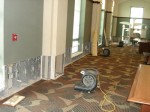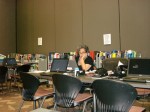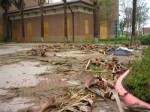Library Disaster Story: Hurricane Dolly
Friday, December 12th, 2008Here is our latest story from a librarian about a disaster that affected the Mario E. Ramirez, M.D. Health Sciences Library at the University of Texas/Harlingen, TX in July 2008.
Interview for “Stories Told”
Name and position title of person telling the story:
Greysi Reyna, Assistant Director, Mario E. Ramirez, M.D. Library
Kathleen Carter, Medical Librarian, Mario E. Ramirez, M.D. Library
Date of the interview:
10/16/2008
(1.) What happened in your community (i.e., what was the disaster/emergency)?
On Monday, July 21, students, faculty and staff at the UT Health Science Center’s Regional Academic Health Center (RAHC) in Harlingen received the official word that a tropical storm, named Dolly, was approaching the Texas coast and was tracking toward South Padre Island, less than an hour’s drive from campus. Most importantly, the storm was projected to intensify to hurricane strength prior to landfall, and the RAHC community had only 48 hours to prepare for the storm.
After reaching Category 2 status, Hurricane Dolly made landfall on the South Texas Coast on Wednesday, July 23, becoming the first hurricane to make a direct hit on Deep South Texas since Hurricane Bret in 1999. With some areas receiving over 9 inches of rain and with winds gusts over 75 mph, widespread damage and flooding was felt throughout the Rio Grande Valley. Tens of thousands of households lost power across Cameron, Willacy and Hidalgo counties.
Despite the efforts to prepare the RAHC for Hurricane Dolly, the building sustained water damage that prevented most RAHC personnel from returning to the building until nearly one week following the storm. In addition, the library was forced to operate from the RAHC’s auditorium for one month while the library underwent repairs.
(2.) How did the library respond? How did the librarian respond? Were there non-traditional (unusual) roles that the librarian performed?
The campus emergency response team, which includes 2 library staff members, called on the campus to begin preparations. Because the Rio Grande Valley is frequently in the path of hurricanes, the RAHC has a well documented Disaster Emergency Timeline for Severe Weather Emergencies. The RAHC Safety Planning Task Force initiated the Emergency Response Plan, and staff of the Mario E. Ramirez, M.D. Library began protecting Ramirez Library resources from the threat of possible wind and water damage, as dictated by the RAHC Disaster Preparation Timeline. While the timeline calls for preparations to begin 96 hours prior to landfall, the timeline was escalated to account for the rapid movement and projected strengthening of Dolly.
While maintaining normal library operations, library staff began removing key print resources from the collection. This included valuable and heavily circulated materials from the general collection along with the entire reserves collection. As part of its hurricane preparedness plan, the library staff routinely place colored dot stickers on the spine of key print resources to help library staff quickly identify, remove and prepare portions of the print collection for storage in the event of a hurricane. To prepare for Hurricane Dolly, this select group of print resources was placed in a secure location on the 2nd floor of the building along with laptop computers, and other critical equipment. In the event that the facility sustained significant damage, these resources would be used to establish a small functioning library in an alternate location.
The remaining collection was covered and secured with plastic sheeting and tarps. Materials located on bottom shelves were moved to the shelves above and covered. All desktop computers and electronics were unplugged, moved away from windows and doorways, and covered with plastic sheeting for protection.
By Tuesday, July 22, the tropical storm had strengthened. Now a hurricane, Dolly, was expected to strike South Padre Island on Wednesday, July 23 with 100 mph winds. RAHC medical students were dismissed at noon that day, and the RAHC staff was encouraged to rush preparations to completion. The Ramirez Library ceased operations at 3:00pm on Tuesday. Windows were boarded and sandbags were placed at building entrances by the campus facilities crew that worked well into the evening that day.
A building restoration team was dispatched to the RAHC during the storm, when it became apparent that water was entering the building. Unfortunately, much of that water entered the Ramirez Library causing considerable water damage. The good news was that the collection, furniture and equipment in the library had been spared. However, portions of walls and sections of carpeting had to be immediately removed, as the RAHC facilities crew and the restoration team began the process of “drying out” the building to prevent the growth of mold.
With the small collection of books and laptops stored prior to the hurricane, the library staff, with the help of RAHC administrators and personnel, opened a small temporary library in the RAHC Auditorium. The Library staff did their best to ensure that library services would continue, despite the circumstances. Medical students were able to check out and return library materials, access the Internet, and the library’s electronic resources.
Nearly a month following Hurricane Dolly’s visit, staff, students and community users were allowed to return to the Ramirez Library, and library operations returned to normal on Friday, August 15. Repairs to the Ramirez Library were on-going for portions of the facility for nearly 3 more months, and the Ramirez Library finally opened the entire space to its users on October 15.
(3.) How has the library (or the services provided) changed as a result of these events?
While the library was able to reopen with minimal downtime, many lessons were learned to help staff prepare for future weather disasters. Since Hurricane Dolly, the following adjustments have been made:
· Librarians have implemented a process for regularly evaluating the print resources that would be removed and stored in the event of a disaster. Labels displaying a hurricane symbol are now placed on the spine of key resources, so they can be easily identified by all staff and stored properly.
· All full time staff have been provided a laptop and docking station so that important documents can be easily backed up on a portable computer. Staff take their laptops with them when they leave the library prior to the hurricane making landfall.
· Should the Library have to operate from an alternate location following a disaster, as with Hurricane Dolly, the Library’s ILS software has been installed on several laptops to ensure that materials can be checked out and returned without interruption.
-
Following Hurricane Dolly, library staff were prepared to serve their users, but staff quickly realized they were not prepared to continue with their regular duties. While the library had carts full of medical books and laptops, basic supplies like paper, folders, and staplers had been left behind. The disaster preparedness plan now stipulates that office equipment and supplies will be removed and stored as well.
· Because cell phone service was unavailable during and after the hurricane, maintaining contact with multiple colleagues was difficult. Now, all staff have been asked to place a single call to the Briscoe Library at the UT Health Science Center San Antonio main campus. Staff at the Briscoe Library will be responsible for relaying information to staff about the status of their co-workers and the Library overall.
(4.) What, in your opinion, are the roles for libraries (and librarians) in disaster planning, response and recovery efforts?
Libraries can share their disaster plans with other agencies, or provide templates for disaster plans. The Ramirez Library has shared its disaster plan with several local libraries and organizations to assist them with developing their own plans.
Before and after a disaster, community members may need help connecting with local resources. The Library can serve as place for distributing information to the community about lodging, drinking water and meals, telephone service, and more!
(5.) What are your experiences working with emergency agencies, organizations and groups?
Overall, the Ramirez Library has a close relationship with the campus security team.
Designated Library personnel are members of the Security Task Force for the Regional Academic Health Center. This means that library staff members are present for all security briefings and have a voice in the decision-making process.
The Ramirez Library staff learned to work with the campus environmental health and safety team. Library staff were required to cooperate with their directives in terms of when it was safe to return to the library due to the possibility of mold formation. Library staff also learned that the campus emergency response team was quick to institute mitigation services to lessen the amount of damage to the library from moisture and mold.
- Books designated to be pulled and removed pre-hurricane














